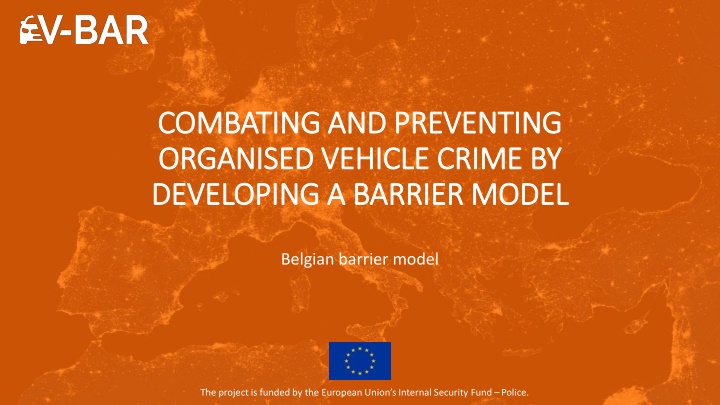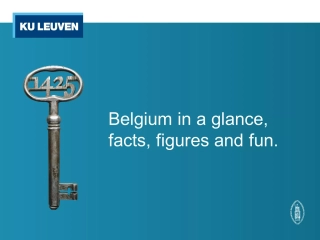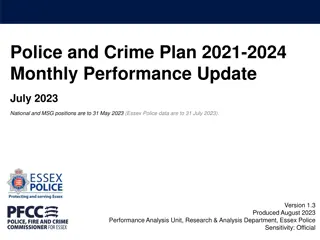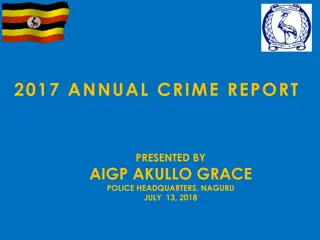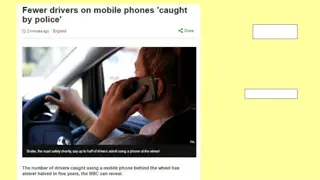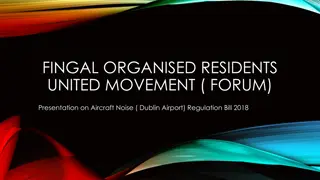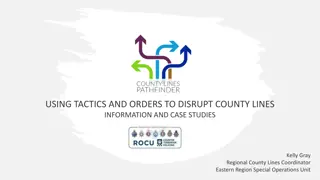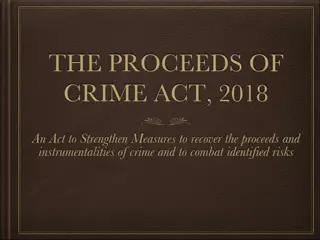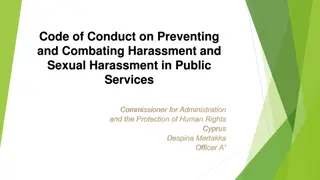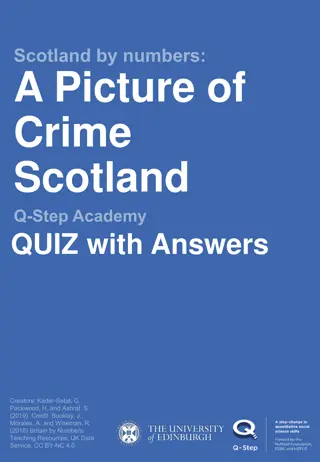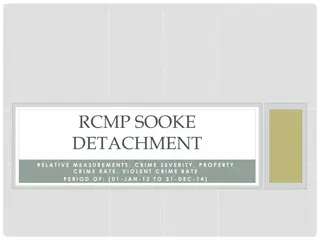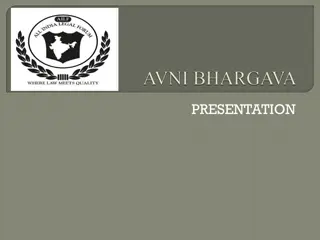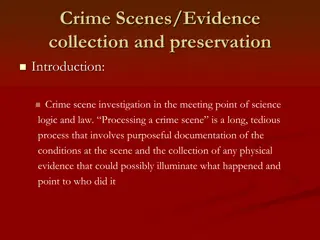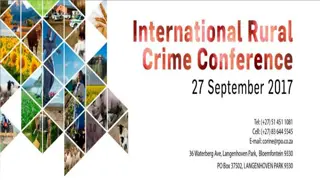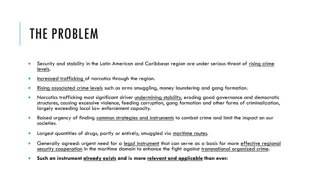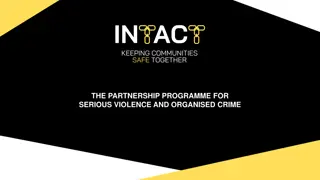Combating and Preventing Organised Vehicle Crime in Belgium
The project in Belgium aims to combat and prevent organised vehicle crime through the development of a barrier model funded by the European Union. Despite a steady decline in motor vehicle theft in Belgium, challenges persist with the absence of specific expertise in law enforcement agencies and hotspots for theft. Organised crime groups employ sophisticated techniques for theft and transportation across borders. Main trends indicate Belgium's position in the top 5 for reporting motor vehicle theft in the EU.
Uploaded on Oct 11, 2024 | 6 Views
Download Presentation

Please find below an Image/Link to download the presentation.
The content on the website is provided AS IS for your information and personal use only. It may not be sold, licensed, or shared on other websites without obtaining consent from the author.If you encounter any issues during the download, it is possible that the publisher has removed the file from their server.
You are allowed to download the files provided on this website for personal or commercial use, subject to the condition that they are used lawfully. All files are the property of their respective owners.
The content on the website is provided AS IS for your information and personal use only. It may not be sold, licensed, or shared on other websites without obtaining consent from the author.
E N D
Presentation Transcript
COMBATING AND PREVENTING COMBATING AND PREVENTING ORGANISED VEHICLE CRIME BY ORGANISED VEHICLE CRIME BY DEVELOPING A BARRIER MODEL DEVELOPING A BARRIER MODEL Belgian barrier model The project is funded by the European Union s Internal Security Fund Police.
Positioning of Belgium in EU General decline or stabilization of MVT in EU 7th position in European Union
Motor vehicle theft in Belgium Steady decline of MVT in Belgium Number dropped by 38% since 2018 Shift from general crime to organised crime No specific priority in National Safety Plans Falls under the General priority: Property Crime No specific expertise or devisions in Belgian law enforcement agencies
Main trends Belgium is in the top 5 of reporting MVT in EU There is a general absence of scientific research with regard to MVT in Belgium Belgium is both a transit and export country for MVT Hot spots: either big cities (Charleroi and Brussels) or border areas (Henegouwen - France, Antwerp and Limburg -The Netherlands and Li ge Germany) Hot brands: Land Rover, Range Rover, SUV s from Lexus and Toyota RAV4 ICT- related techniques are mostly used: Track and Tracing Relay and Replay attacks: interception of information between the key fob and the vehicle through a Man in the Middle attack Reprogramming of car keys Jamming the signal between key fob and vehicle
(Mobile) Organised Crime Groups and Modus Operandi 1. The Hit & Run MO Belgian organized crime groups or groups from neighboring countries Commit the theft and leave immediately Vehicle gets driven across border The Eastern European MO Eastern European crime groups enter and stay for a couple of weeks More sophisticated methods of target identification Multiple thefts (2-4 vehicles) by Relay and Replay attacks Transport by road in container to Eastern Europe The Central & South African MO Criminal network resides in Belgium Theft on demand More sophisticated methods of target identification Multiple thefts by Relay and Replay attacks Transport by sea (Belgian or neighboring countries ports) to Central or South Africa 2. 3.
The Belgian Barrier Model Blue: the process steps that are being shared by all criminal organizations and MO s Green: the ones shared by Eastern European and African criminals in green Red: (entry) is reportedly only being used by the Eastern European MO. Proposed extra steps: preparation of crime and post-crime
Step 1: Entry Step 1: Entry Opportunities Open borders Schengen Area Low cost travel and limited documentation checks Anonymous travel, public transport and car rental Limited and old ANPR camera system Lack of resources for LEA s Signals Limited signs and little ground for checks as the crime has not yet been committed During random traffic checks: tools in vehicle, criminal record,.. Facilitators & Partners Telecom companies Car rental companies Airports, railways and flix busses Car manufacturers Barriers Training and resources for LEA Expanding and renewing ANPR camera network + synchronizing databases in EU Database for private sector and LEA the lighthouse project
Step 2: Stay Step 2: Stay Opportunities No registration needed with family and criminal network Campings and AirBnb s: minimal identification and registration Cash transactions are still permitted Little time and resources for community police officers Signals Overcrowding and late night activity License plates on vehicles (changing plates, different plates front/back, multiple foreign plates,..) Facilitators & Partners Family and criminal network Community police officers Mayor & Municipality Private sector: AirBnb, campings, hotels Barriers Resources for community police officers / changes in organisational structure of LEA Better regulation and enforcement of registration and identification of guests (AirBnb s and campings) Building cooperation and trust between private sector and LEA
Step 3: Infrastructure Step 3: Infrastructure Opportunities Lack of patrols of LEA Fast, easy and anonymous movement within EU ANPR camera system: small amount, bad quality, four different ANPR systems which are not compatible to each other, faults in system, unevenly distributed Multiple big ports Large amount of parking garages and public parking spaces Signals Limited signs and little ground for checks as the crime has not yet been committed During random traffic checks: tools in vehicle, criminal record,.. Facilitators & Partners LEA Parking garages and public parking attendants Barriers Expansion and upgrade of ANPR camera system + EU synchronization Data sharing tools between private sector and LEA (lighthouse project)
Step 4: Crime Step 4: Crime Opportunities pre-crime Large amount of luxurypre-crime vehicles and public/private parking spaces (target selection) Easy access to VPN s and encrypted apps for communication Easy access to tracking and jamming devices Opportunities during theft Easy access to lock picking devices, relay and replay attack tools, reprogramming tools, jamming devices,.. Easy use of these devices and online tutorials Standardized cryptography, lack of variation in key codes, slow implementation of new anti-theft measures and irregular updates of unsecure systems by manufacturers Opportunities post-crime Open borders in Schengen Area Easy access to jammers that block the LoJack Frequency Trackers of manufacturers Difficult procedural requirements to access data between private sector and LEA (slow detection) Signals Location, time and space principle Previous criminal activity/ criminal record/ known locations/ ANPR alerts
Step 4: Crime Step 4: Crime Facilitators Criminal network Malicious car dealerships Malicious car repair shops or chop shops The dark web/ AliExpress/ Wish Partners ICT developers and white hat hackers Car manufacturers Internet shops Civilians and media (awareness) Car dealerships and repair shops LEA Insurance companies Barriers Comprehensive cooperation of LEA in EU and private sector Awareness campaigns for civilians that promote anti-theft measures Promoting anti-theft measures by all private sector partners (insurance companies, car rental companies, car dealerships and car manufacturers) in general Expanding cooperation between car manufacturers and ICT experts/white hat hackers
Step 5: Storage Step 5: Storage Opportunities Large amount of vacant firms, storage facilities and (malicious) car dealerships and repair shops No ID-checks for rental or squatting of abandoned sites Signals Cooling down process: stolen cars in public parking lots or spaces Nightly activity at car repair shops, car dealerships and storage facilities Facilitators & Partners Criminal network (malicious) car dealerships and car repair shops Car park operators or public parking attendants Storage facility owners LEA Labor and social inspection services Barriers Training and resources for LEA Awareness campaigns for rental companies, legitimate car repair ships and civilians Information sharing between car manufacturers, parking attendants and LEA More control of labor and social inspection services with specific focus on car dealerships and repair shops
Step 6: Transport & Trade Step 6: Transport & Trade General opportunities High demand and value of stolen car parts in EU Cars and car parts are not inherently illegal difficult identification by customs and shipping companies No coherent policies of data collection by shipping companies Easy infiltration of existing legal circuits of transport and trade in vehicle parts Easy access to VPN s and encrypted apps for communication Opportunities for transport by road Open borders in Schengen Area Easy switching of license plates Poor working conditions in some Eastern European countries and low wages Opportunities for transport overseas Massive amount of container shipments everyday and limited resources for customs and expedition offices Multiple options of ports in Belgium and neighboring countries Opportunities within the vehicle trade Easy infiltration or establishment of car dealerships Easy access to online secondhand websites with varying levels of security Limited resources for vehicle registration agencies and lack of Car-Pass multiple VIN control Car Pass not required in all EU countries
Step 6: Transport & Trade Step 6: Transport & Trade Signals Patterns in registration at expedition offices False documentation Refurbished cars at vehicle inspection services Cheap parts or vehicles on online platforms Vehicles stacked on lorries and in containers without care Facilitators and Partners Expedition offices, truck drivers and scrap yards Websites or online secondhand platforms Customs and LEA Vehicle inspection services and postal services Barriers A coherent EU policy on the minimum requirements for data collection in the private sector A EU initiative to expand the Car-Pass system to all EU countries and a synchronized database A EU initiative on prohibiting cash transactions within the new and secondhand car market More EU cooperation projects (example: PARSEC) More resources for custom agencies and car inspection services and better training for LEAs Better regulation and minimum requirements for expedition offices Creating more effective automated programs for document identification
Step 7: Profit Step 7: Profit Opportunities Limited checks and balances in the second hand car market abroad Cars have a lot of value to exchange/barter in the criminal world Money laundering opportunities Easy access to encrypted apps and cash transfers (WesternUnion) Signals Multiple cash exchanges/ bank transfers/ cash deposits within one family or business Living standards in comparison to official employment Facilitators & Partners Secondhand car dealerships abroad Criminal network and terrorists Money transfer services Financial institutions Barriers Better and more automated tracking of money trails Restriction of cash transactions Better risk factor analysis by financial institutions More efficient tracking of cryptocurrency trades
Discussion & conclusion Limited research and expertise in Belgium so vulnerable model Infrastructure of LEA results in no information sharing between regional police, trends are therefore regionally and not nationally Model is out of balance because LEA mostly focusses on steps after the crime is committed Delineation of the scope to MVT ignores other crimes i.e. fraud and excludes important partners (i.e. insurance sector) Some important stakeholders were not willing to cooperate thus there is data missing Both LEA and private sector advocate for cooperation but there is a noticeable distrust To be effective, an integrated approach is necessary MVT and modus operandi are flexible, the barrier model needs to reflect this
Thank you for your attention! V-BAR seeks to analyse the dynamics of the criminal markets of motor vehicle theft and stolen vehicle parts in the EU. Based on logistical analyses of these markets in 6 EU Member States, V-BAR will develop a European barrier model of organised vehicle theft and stolen vehicle parts. For more information visit www.vehiclecrimebarrier.eu or our LinkedIn page. The project is funded by the European Union s Internal Security Fund Police.
